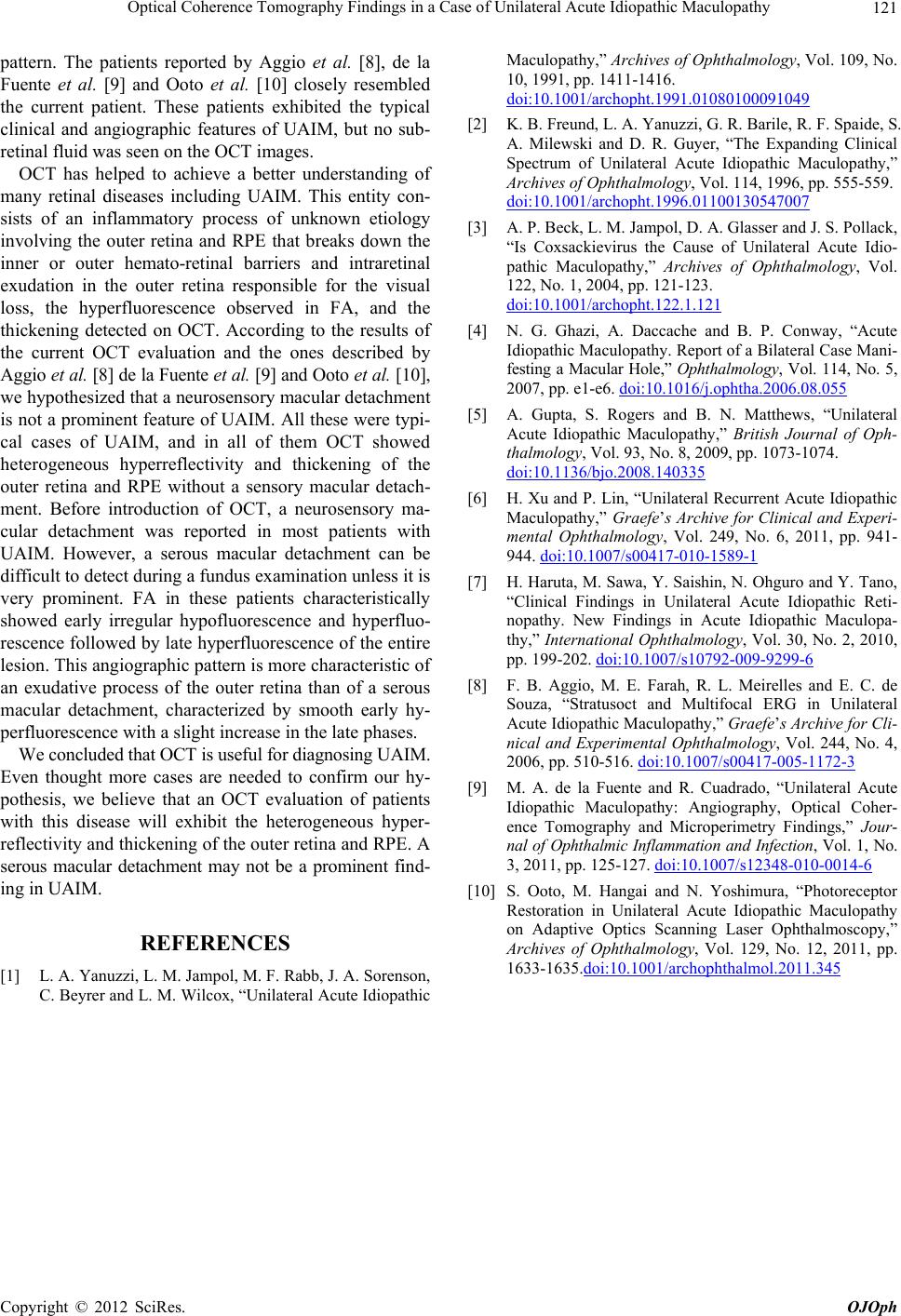
Optical Coherence Tomograph y Findings in a Cas e of Unilateral Acute Idiopathic Maculopathy
Copyright © 2012 SciRes. OJOph
121
pattern. The patients reported by Aggio et al. [8], de la
Fuente et al. [9] and Ooto et al. [10] closely resembled
the current patient. These patients exhibited the typical
clinical and angiographic features of UAIM, but no sub-
retinal fluid was seen on the OCT images.
OCT has helped to achieve a better understanding of
many retinal diseases including UAIM. This entity con-
sists of an inflammatory process of unknown etiology
involving the outer retina and RPE that breaks down the
inner or outer hemato-retinal barriers and intraretinal
exudation in the outer retina responsible for the visual
loss, the hyperfluorescence observed in FA, and the
thickening detected on OCT. According to the results of
the current OCT evaluation and the ones described by
Aggio et al. [8] de la Fuente et al. [9] and Ooto et al. [10],
we hypothesized that a neurosensory macular detachment
is not a prominent feature of UAIM. All these were typi-
cal cases of UAIM, and in all of them OCT showed
heterogeneous hyperreflectivity and thickening of the
outer retina and RPE without a sensory macular detach-
ment. Before introduction of OCT, a neurosensory ma-
cular detachment was reported in most patients with
UAIM. However, a serous macular detachment can be
difficult to detect during a fundus examination unless it is
very prominent. FA in these patients characteristically
showed early irregular hypofluorescence and hyperfluo-
rescence followed by late hyperfluorescence of the entire
lesion. This angiographic pa ttern is more characteristic of
an exudative process of the outer retina than of a serous
macular detachment, characterized by smooth early hy-
perfluorescence with a slight increase in the late phases.
We concluded that OCT is useful for di agnosi ng UAIM .
Even thought more cases are needed to confirm our hy-
pothesis, we believe that an OCT evaluation of patients
with this disease will exhibit the heterogeneous hyper-
reflectivity and thickening of the outer retin a and RPE. A
serous macular detachment may not be a prominent find-
ing in UAIM.
REFERENCES
[1] L. A. Yanuzzi, L. M. Jampol, M. F. Rabb, J. A. Sorenson,
C. Beyrer and L. M. Wilcox, “Unilateral Acute Idiopathic
Maculopathy,” Archives of Ophthalmology, Vol. 109, No.
10, 1991, pp. 1411-1416.
doi:10.1001/archopht.1991.01080100091049
[2] K. B. Freund, L. A. Yanuzzi, G. R. Barile, R. F. Spaide, S.
A. Milewski and D. R. Guyer, “The Expanding Clinical
Spectrum of Unilateral Acute Idiopathic Maculopathy,”
Archives of Ophthalmology, Vol. 114, 1996, pp. 555-559.
doi:10.1001/archopht.1996.01100130547007
[3] A. P. Beck, L. M. Jampol, D. A. Glasser and J. S. Pollack,
“Is Coxsackievirus the Cause of Unilateral Acute Idio-
pathic Maculopathy,” Archives of Ophthalmology, Vol.
122, No. 1, 2004, pp. 121-123.
doi:10.1001/archopht.122.1.121
[4] N. G. Ghazi, A. Daccache and B. P. Conway, “Acute
Idiopathic Maculopathy. Report of a Bilateral Case Mani-
festing a Macular Hole,” Ophthalmology, Vol. 114, No. 5,
2007, pp. e1-e6. doi:10.1016/j.ophtha.2006.08.055
[5] A. Gupta, S. Rogers and B. N. Matthews, “Unilateral
Acute Idiopathic Maculopathy,” British Journal of Oph-
thalmology, Vol. 93, No. 8, 2009, pp. 1073-1074.
doi:10.1136/bjo.2008.140335
[6] H. Xu and P. Lin, “Unilateral Recurre nt Acute Idiopat hic
Maculopathy,” Graefe’s Archive for Clinical and Experi-
mental Ophthalmology, Vol. 249, No. 6, 2011, pp. 941-
944. doi:10.1007/s00417-010-1589-1
[7] H. Haruta, M. Sawa, Y. Saishin, N. Ohguro and Y. Tano,
“Clinical Findings in Unilateral Acute Idiopathic Reti-
nopathy. New Findings in Acute Idiopathic Maculopa-
thy,” International Ophthalmology, Vol. 30, No. 2, 2010,
pp. 199-202. doi:10.1007/s10792-009-9299-6
[8] F. B. Aggio, M. E. Farah, R. L. Meirelles and E. C. de
Souza, “Stratusoct and Multifocal ERG in Unilateral
Acute Idiopathic Maculopathy,” Graefe’s Archive for Cli-
nical and Experimental Ophthalmology, Vol. 244, No. 4,
2006, pp. 510-516. doi:10.1007/s00417-005-1172-3
[9] M. A. de la Fuente and R. Cuadrado, “Unilateral Acute
Idiopathic Maculopathy: Angiography, Optical Coher-
ence Tomography and Microperimetry Findings,” Jour-
nal of Ophthalmic Inflammatio n and Infection, Vol. 1, No.
3, 2011, pp. 125-127. doi:10.1007/s12348-010-0014-6
[10] S. Ooto, M. Hangai and N. Yoshimura, “Photoreceptor
Restoration in Unilateral Acute Idiopathic Maculopathy
on Adaptive Optics Scanning Laser Ophthalmoscopy,”
Archives of Ophthalmology, Vol. 129, No. 12, 2011, pp.
1633-1635.doi:10.1001/archophthalmol.2011.345